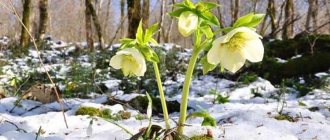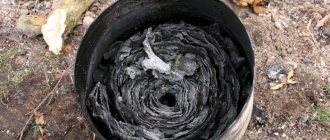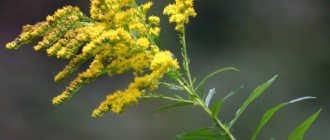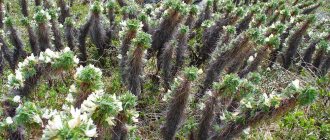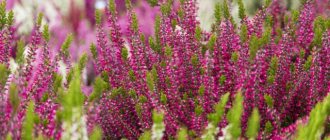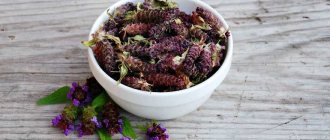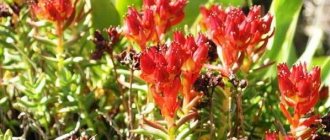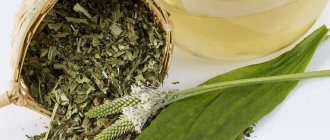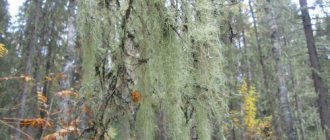Botanical description
More than 80 species of this plant are known, but from a medical point of view, only Parmelia wandering, or, as it is also called, cut grass, is of interest. This is a perennial lichen growing on steppe and semi-desert soils, the leaf thallus of which reaches 5 cm in height.
The body is branched, leathery-cartilaginous, slightly shiny. The narrow, grooved bare lobes are colored greenish-gray on top. The lower edge of the thallus is dark brown.
The species is named wandering for its ability to move to a new place with strong gusts of wind.
In central Russia, parmelia furrow is sometimes mistakenly called cut grass. This lichen, large rosettes of which are often found on the trunks and branches of deciduous trees, is not recognized as medicinal.
It can be distinguished by the foliose thallus tightly attached by rhizines to the substrate, the thinly branched, wide lobes of which can be colored yellowish or whitish-gray on top.
Spreading
Parmelia loves light and warmth, is undemanding to the soil, and is resistant to adverse atmospheric and man-made phenomena. It is found on saline chestnut soils of steppes and semi-deserts, rocky substrate of mountain slopes, and occasionally temporarily attaches to the trunks and branches of deciduous trees.
Distributed in the southern regions of the former USSR.
Active ingredients
Parmelia vagusum is valued for its high content of usnic acid, which has antiviral, antibiotic, analgesic and anti-tuberculosis effects.
The cut grass also contains barbate, squamate and fumarprocertratic acids, which makes it suitable for the treatment of diarrhea and hemorrhoids.
Substances similar to tannin have a hemostatic effect and are even suitable for use as an antidote for lead and mercury poisoning.
The gelling substance lichenin is not absorbed by the human body and has an enveloping effect, due to which parmelia decoctions and jelly are used as an aid in the treatment of intestinal and stomach ulcers.
The high concentration of vitamin C and the acid-rich composition of the thallus do a good job of strengthening the immune system.
Potassium, calcium, phosphorus, isolichenin and evenin do not play a significant role.
For dry and productive cough
For both men and women, parmelia is most commonly recommended for the treatment of coughs and respiratory infections.
Carbohydrates (professionally called mucilages) have the ability to bind water and create viscous solutions. This helps dilute mucus and remove it. The plant is also useful for dry coughs, creating a coating on irritated mucous membranes, protecting them and promoting soothing.
Article for you:
Dill - health benefits and harms
Therefore, traditional medicine recommends drinking parmelia tea to treat bronchitis and as an additional therapeutic agent for asthma.
- In addition to lichen, mixtures designed to improve mucus discharge include marshmallow, mallow, podbel, plantain and flaxseed.
- For dry cough, a mixture of lichen with plantain, podbelom and flaxseed is suitable.
The following recipes will help get rid of cough and help treat bronchitis.
Recipe No. 1
1 tbsp. dry crushed raw materials, pour 1 glass of milk and cook for 15 minutes. Have a drink at night. Milk medicine has a softening, soothing and mucolytic effect.
Recipe No. 2
Pour 40 g of dry raw material with 250 ml of alcohol (60%). Leave for 7 days. Take 10 drops per day. Parmelia alcohol tincture inhibits inflammation and normalizes the metabolic functioning of the body.
Medicinal properties
For the antiseptic and regenerative properties of parmelia, they gave it a second name - cut grass. A strong decoction is used to wash wounds. Vaseline paste with lichen powder is suitable for dressings.
Parmelia is used for coughs due to its emollient and soothing effect on the mucous membrane of the respiratory tract. A decoction with milk is recognized by traditional medicine as an effective anti-tuberculosis remedy.
Parmelia wandering helps with gastrointestinal diseases, acute colitis, toxic dyspepsia. Often used as an immunostimulant.
Analgesic, anti-inflammatory and hemostatic properties are used in the fight against hemorrhoids and cystitis. Antifungal and immunostimulating effects are used in the treatment of thrush, where the grass plays a supporting role.
Usage history
The medicinal properties of the plant have long been used in folk medicine in Northern Europe. Until today, it is not only a valuable natural medicine, but also an important food product.
In the northern regions, moss is used to produce flour, which (mixed with other grains) is used to bake Christmas cookies. By fermentation, a sour drink beloved by northerners is prepared from it, which is diluted with water before use.
Article for you:
What are the benefits of greens and garlic arrows, for whom are they harmful to health?
Lichen was also used as a salt substitute for preserving meat. Since the 18th century, records of the uses and contraindications of parmelia lichen have been found in many European pharmacopoeias. Modern instructions for use of the plant indicate its positive effects on asthma, tuberculosis, bladder and kidney diseases.
Indications for use
Parmelia wandering is a case when the healing properties of a folk remedy are recognized by official medicine.
It is suitable for both external and internal use.
Washing with a strong decoction of lichen is indicated for damage to the skin, such as:
- burn;
- frostbite;
- cut or abrasion;
- bedsore;
- trophic ulcer.
Dressings with bandages soaked in the broth are useful. Self-treatment of penetrating wounds and cuts is prohibited: in combination with the wound-healing properties of parmelia, insufficient sterilization of the internal layers of the damage leads to the formation of an abscess.
Oral intake of parmelia is indicated for diseases:
- respiratory tract - chronic cough, bronchial asthma, influenza, tuberculosis;
- digestive tract - infections, stomach and duodenal ulcers, colitis;
- heart and blood vessels.
Like cetraria, it is used for douching for:
- bacterial cystitis;
- hemorrhoids.
Lichen is used quite rarely as an independent medicine. Usually it plays the role of an auxiliary tool. To prevent complications, it is better not to ignore this fact and not to get carried away with self-medication.
Especially if the patient is a child.
Parmelia, due to its medicinal immunomodulatory properties, is popular in East Asia and Central Europe, where it is used as a dietary supplement. It is possible to add a small amount of chopped grass, ground into powder, to the flour, or use it as a thickener when preparing jelly, jelly or jelly.
The slight heat and bitterness in the finished dish is interrupted by fruit juices.
Basic recipe
There is no single way to brew Parmelia properly. The oldest recipe for preparing a natural therapeutic remedy is as follows.
Previously, traditional healers argued that if you want to prepare a concentrated infusion, it is best to do this by cold infusion. 2 tbsp. Rinse the raw materials well (for example, on a sieve), place in a glass jar, add 1/2 liter of cold water and leave overnight (about 8 hours). This preparation process is as gentle as possible on mucous and other substances that are leached from the lichen into the aqueous solution. According to ancient healers, when boiling, more mucus is destroyed, which reduces the beneficial properties of the medicine.
Article for you:
Celery: benefits and harm to human health
Contraindications
Individual intolerance is the main contraindication. If urticaria or other forms of allergic reaction occur, you should stop taking the medicine and contact a medical facility.
The effect of Parmelia has not yet been fully studied, so contraindications include:
- age up to 6 years;
- pregnancy;
- lactation.
For hypertension, parmelia is used only as prescribed by the attending physician. To avoid side effects, special attention should be paid to carefully following the dosage indicated in the instructions.
Procurement and storage of raw materials
The concentration of usnic acid in lichen increases with increasing daylight hours, reaching a peak value of 8% of dry matter mass and decreases after the summer solstice. Therefore, it is recommended to collect parmelia in May-June.
The medicinal thallus is dried in the open air; shade is not necessary. Completely dried lichen loses its pungent odor and has a tart, pungent taste.
Properly prepared raw materials will not lose their healing properties for 3-4 years, regardless of temperature and lighting level.
Dry raw materials should be stored in tightly closed containers.
Instructions for use
There are many folk recipes in which parmelia is the main component. The instructions must be read in advance, before starting treatment.
For adults
A decoction of such a plant helps cure diarrhea, gastrointestinal diseases, colitis, and cough. It is not difficult to prepare the product. You will need 3 teaspoons of dry raw materials. They pour 300 ml of boiling water, cook the mixture over low heat for ten minutes. Next, you need to infuse the solution for two hours and strain. The finished medicine is taken before meals 3-4 times a day, one tablespoon. The course of treatment should not exceed thirty days. The prepared broth cannot be stored in the refrigerator for more than two days.
If you need to cure the surface of the skin, eliminate wounds and scratches, you should prepare a special product. You need to mix 3 tablespoons with 300 ml of boiling water. The mixture is simmered over low heat for ten minutes, then infused for two hours. The solution must be filtered and used externally, in the form of compresses. The medicine cleanses the wound of pathogenic bacteria and promotes healing.
For stomach diseases, you should use a tincture from this plant. To prepare it, you need to use dried herbs. It is mixed with 200 ml of boiling water. The solution is infused for two hours and filtered. Take one tablespoon 3-4 times a day, half an hour before meals. Treatment lasts from 5 to 20 days. The strained infusion cannot be stored for more than one day. With proper preparation and administration of the product, you can quickly recover and become healthy.
For children
Children are allowed to use this plant for colds and coughs. The product helps to recover faster and get rid of unpleasant sensations.
The decoction does not take long to prepare. You need to mix one tablespoon of dry herb and one liter of water. The pan with the solution is placed in a water bath and left for about two hours. Then remove from heat and strain. You should take the medicine one-third of a glass three times a day, half an hour before meals. The solution is stored in the refrigerator for no more than one day; the product is heated before use. If your baby develops a rash on the skin after treatment with this plant, its use should be stopped. The child may be allergic to parmelia.
Parmelia should not be used during pregnancy. The plant can bring harm rather than benefit. During this period, a woman’s body is susceptible to various diseases and may be weakened. The product may cause diseases. Its use should be abandoned to avoid complications and side effects.
Where can I collect?
Parmelia is a complex organism, a combination of fungal and algal cells. Like all lichens, it does not filter water, but absorbs moisture completely, along with all the heavy metals and radioactive isotopes it contains.
As a result, the cut grass dies, but rather slowly and it is difficult to distinguish a healthy specimen from a contaminated one. Therefore, an important condition for proper collection of thallus is distance from industrial zones, large cities and highways.
As a preventive measure
Teas or preparations with Parmelia lichen are good preventive measures. They are part of the medical “arsenal” of supporters of a healthy lifestyle, because... Thanks to a good combination of active substances, they help strengthen the body's defenses. At the same time, they help alleviate moderate health problems:
- in case of irritable cough and hoarseness,
- the reception is advisable for people who often stay in air-conditioned rooms, where dry air dries out the mucous membranes of the respiratory tract,
- Moss-based products are indicated for people prone to overstrain of the vocal cords (teachers, speakers, singers, etc.).
